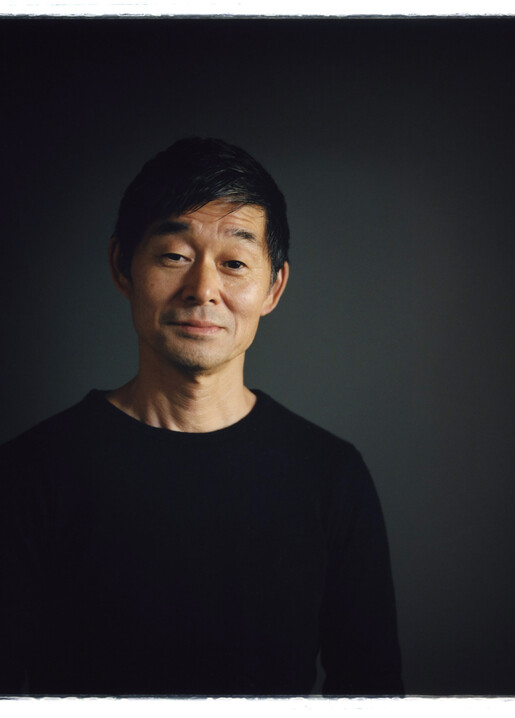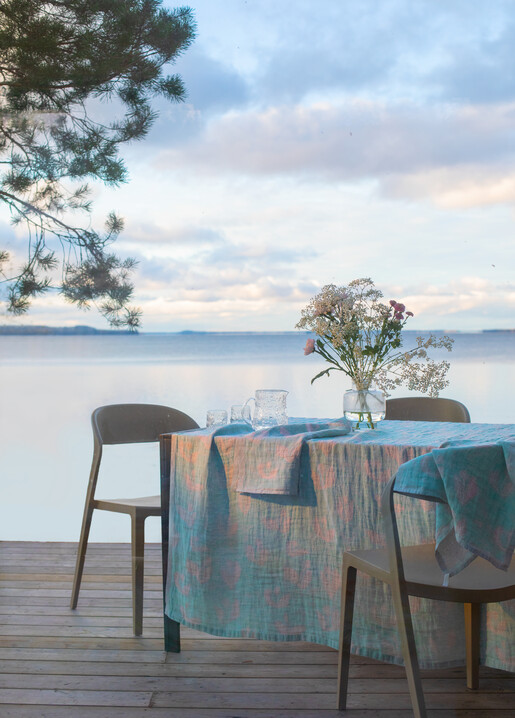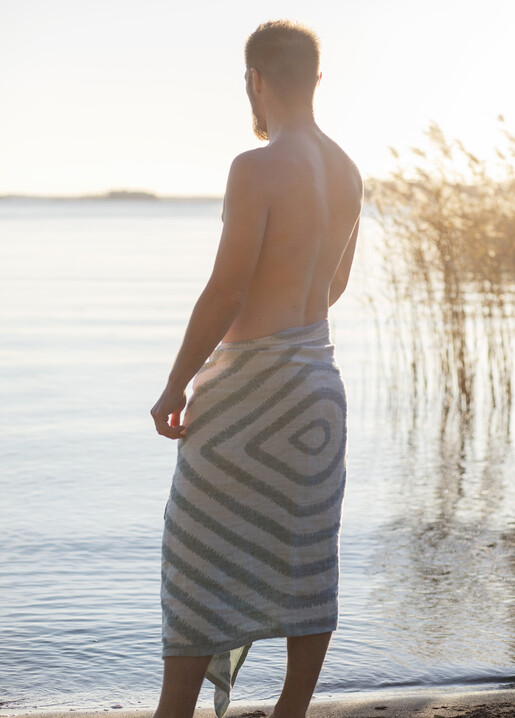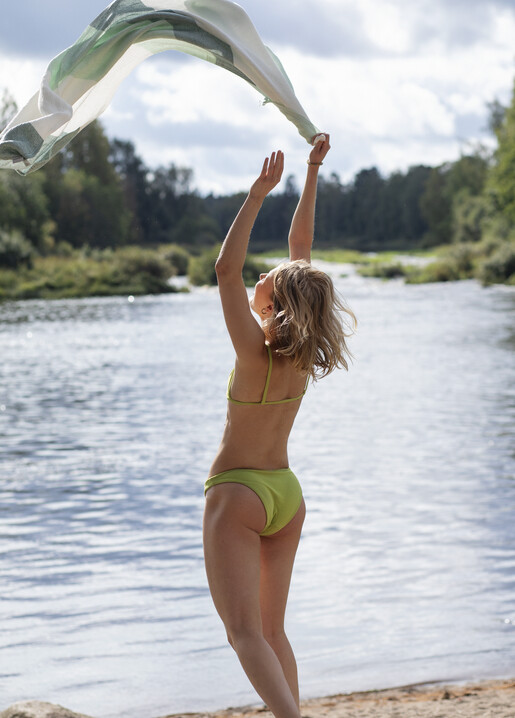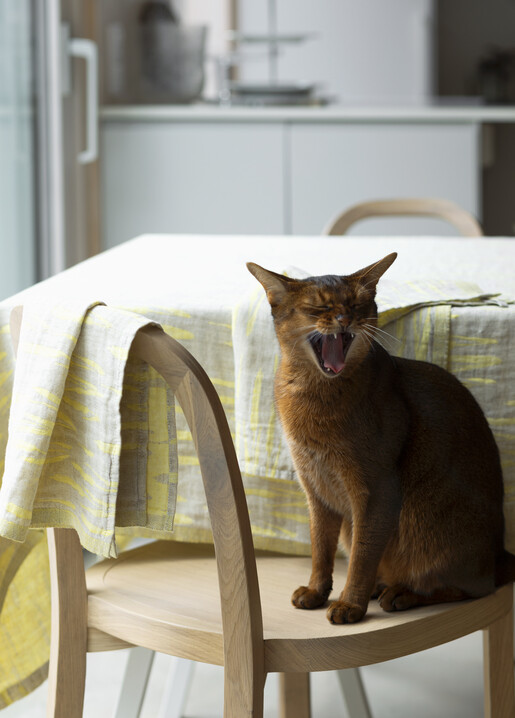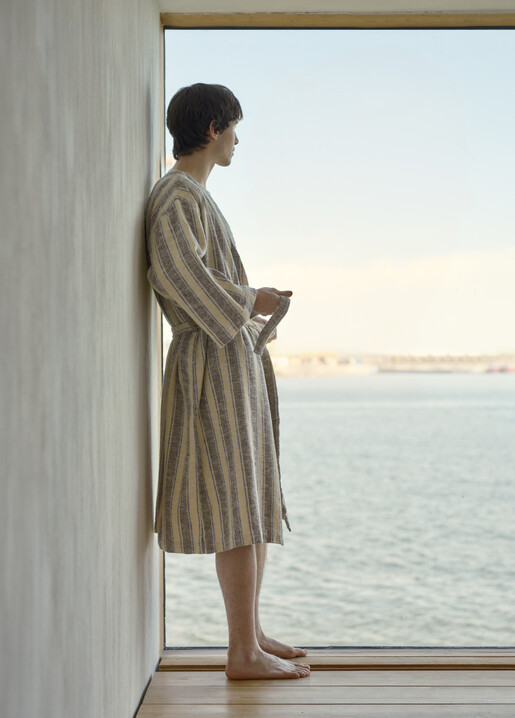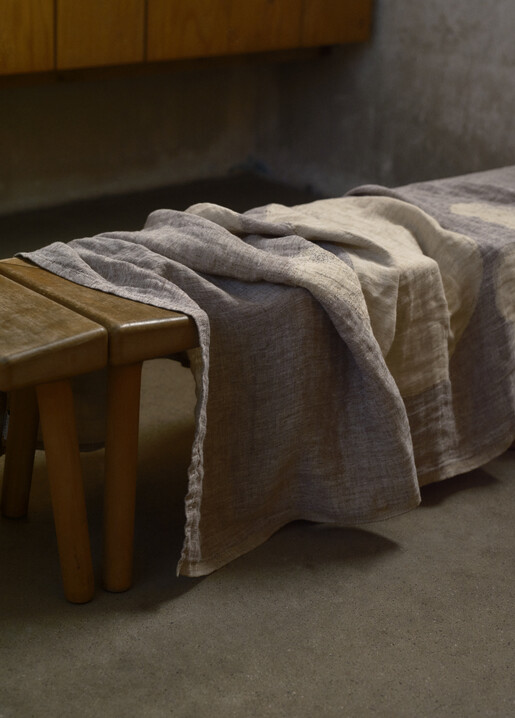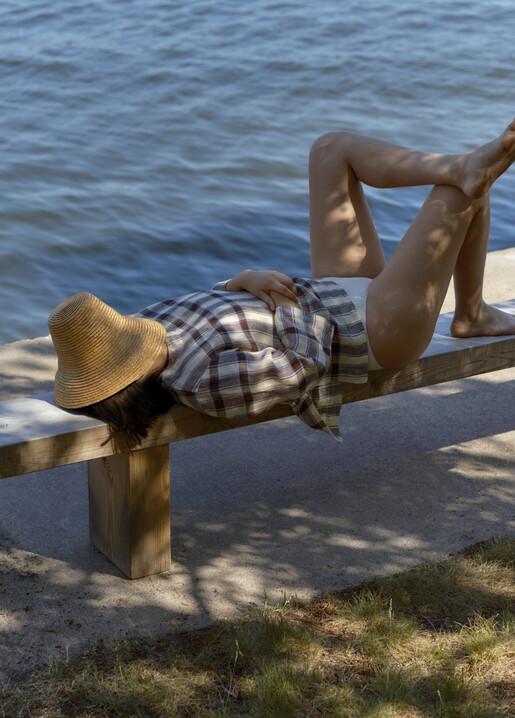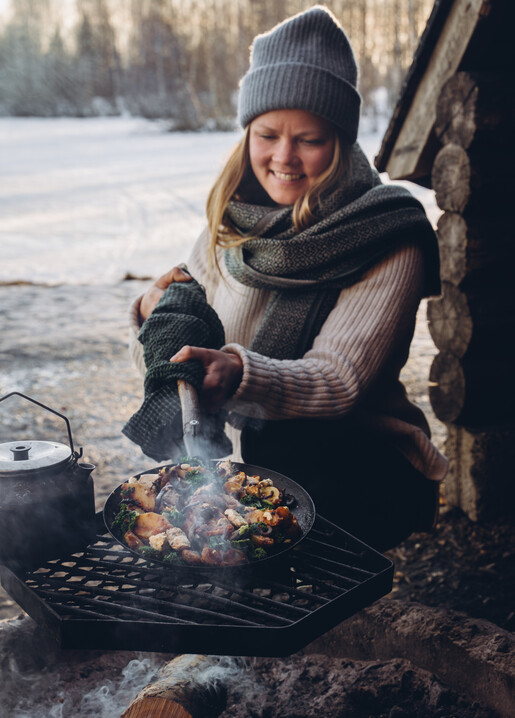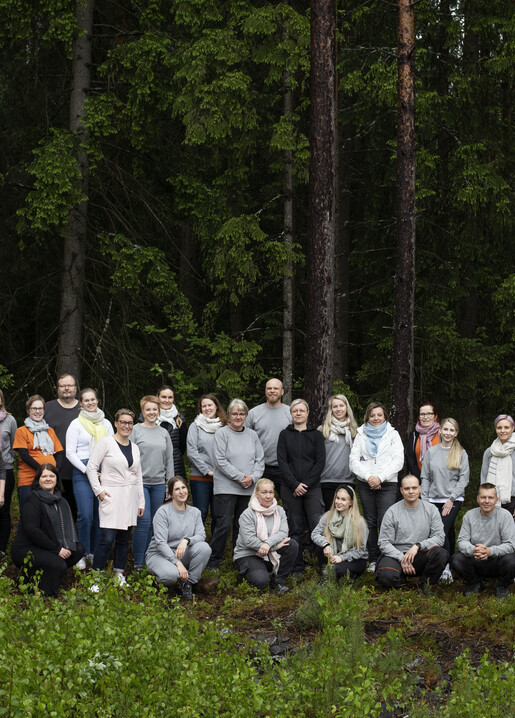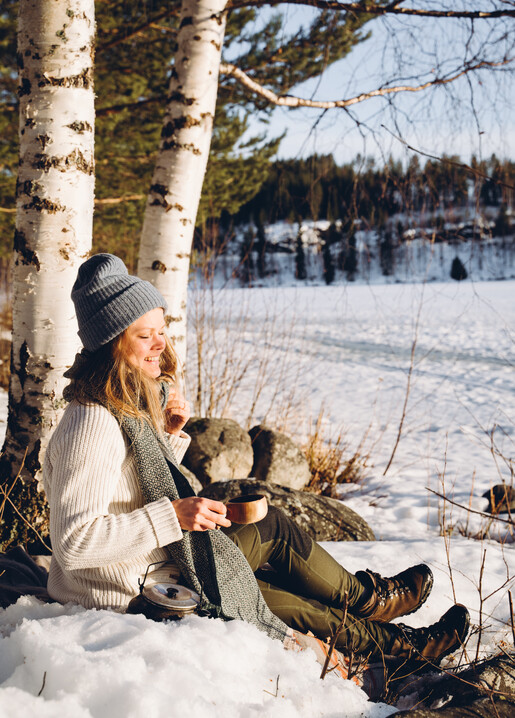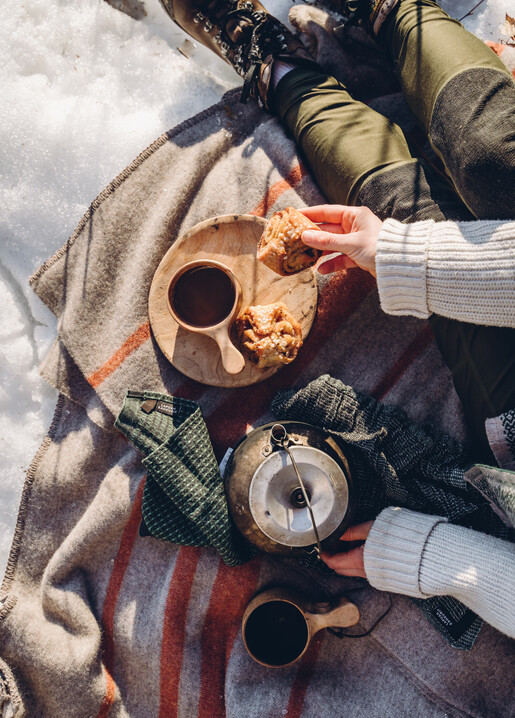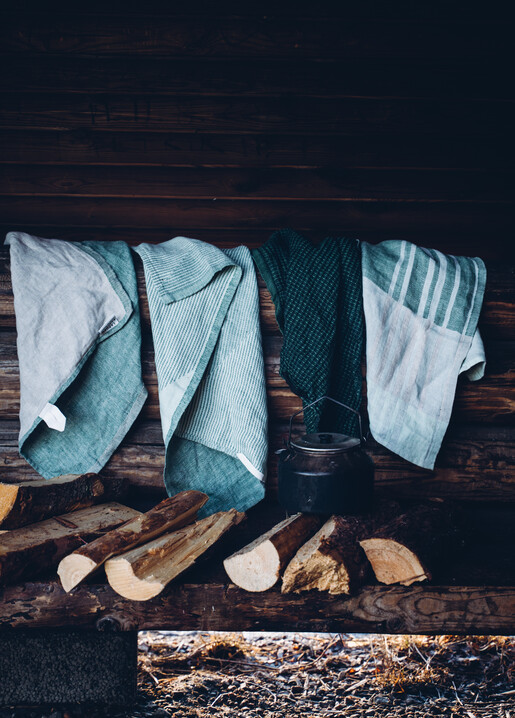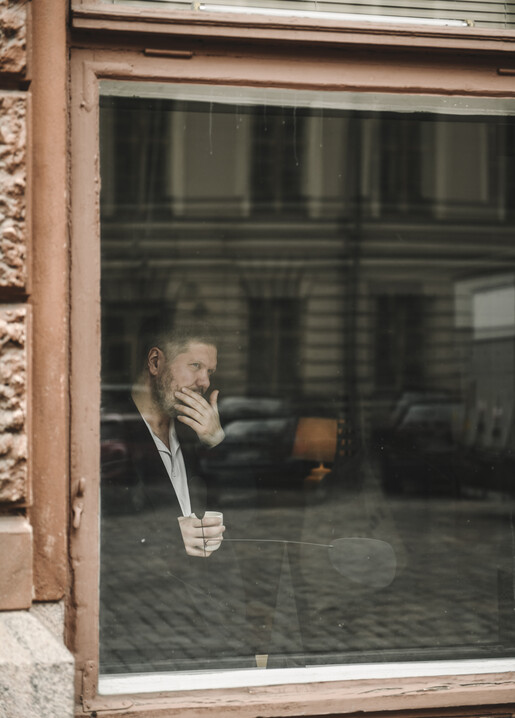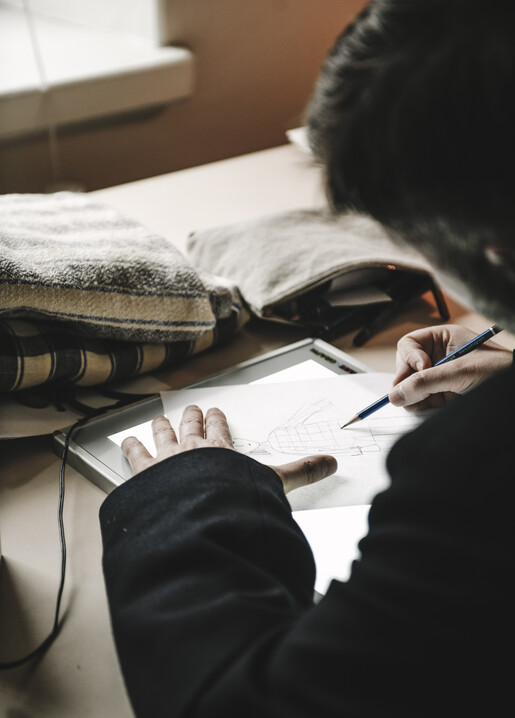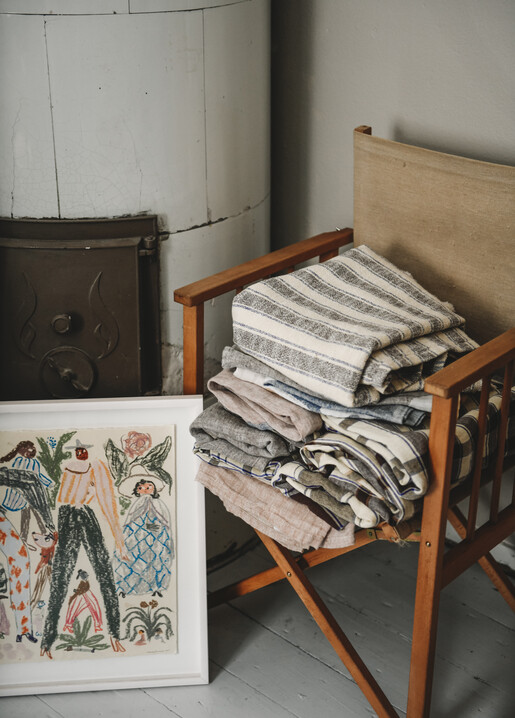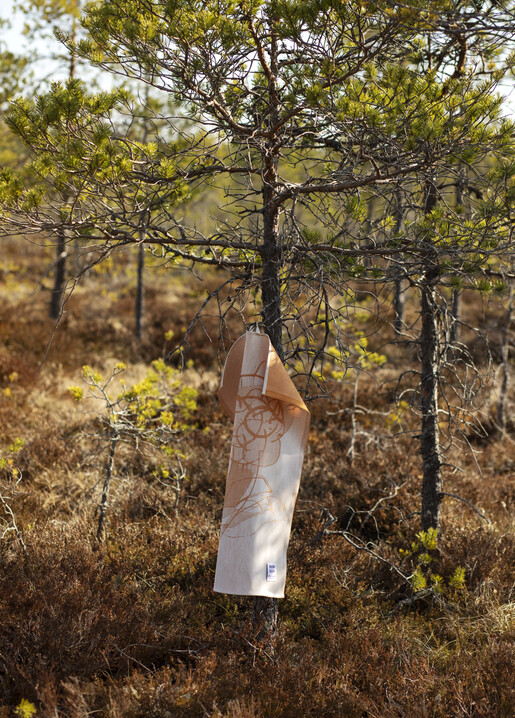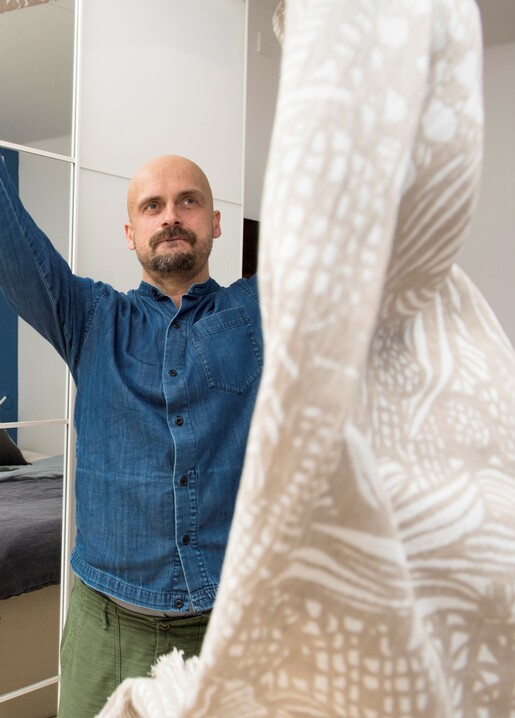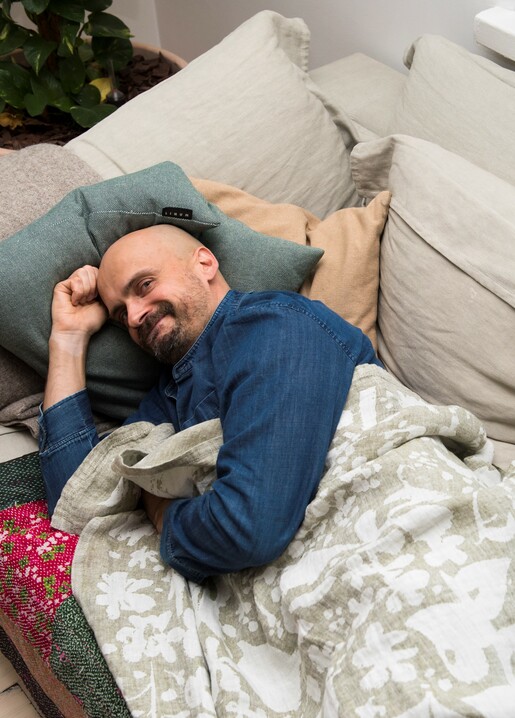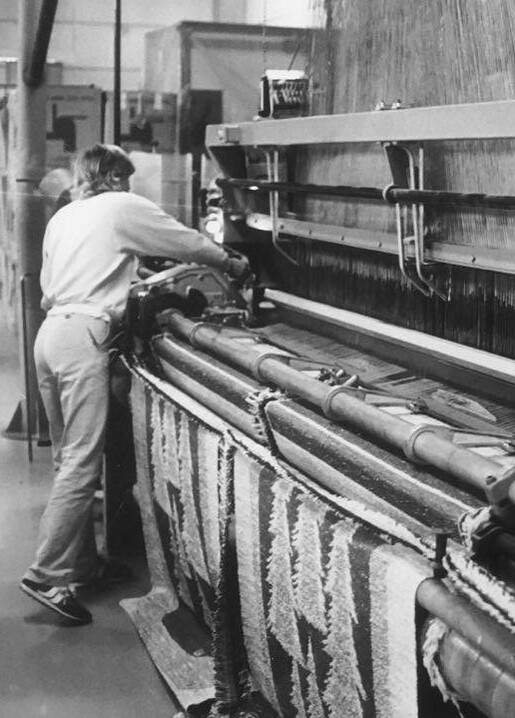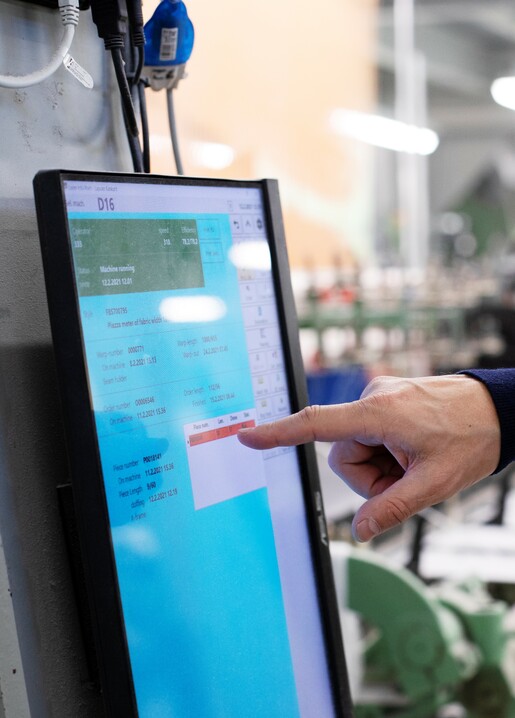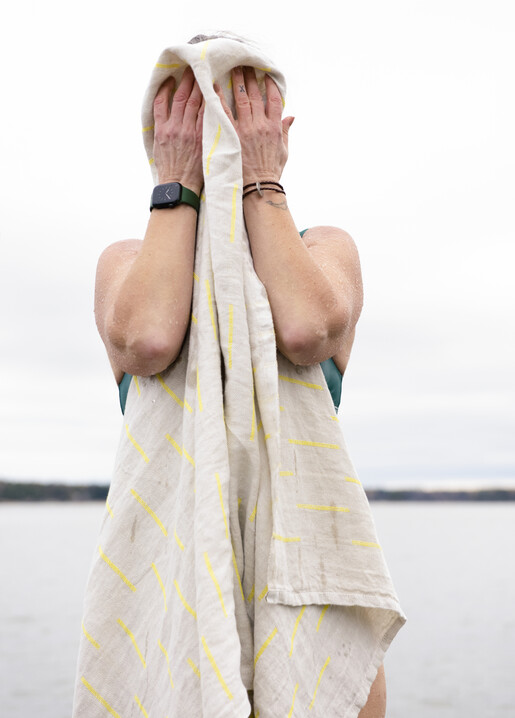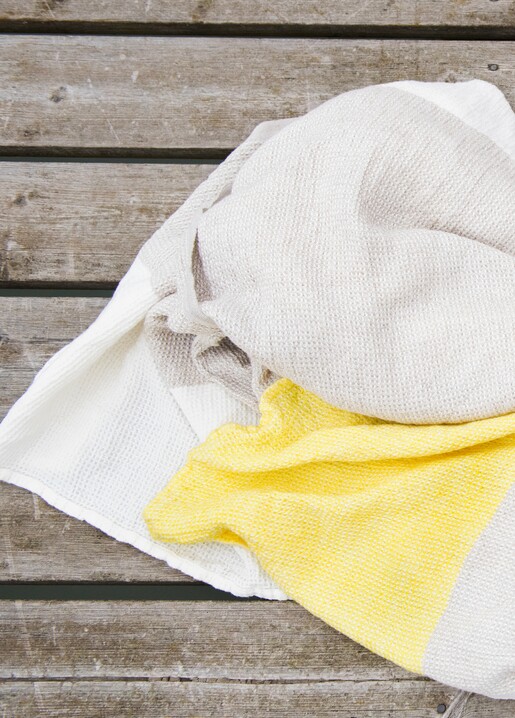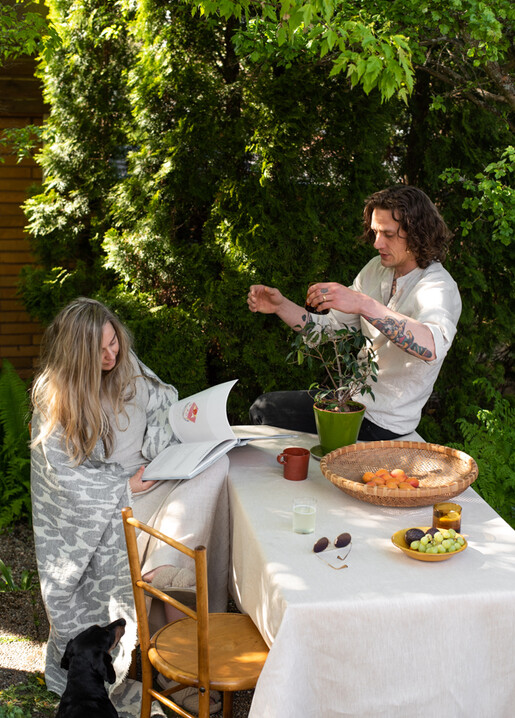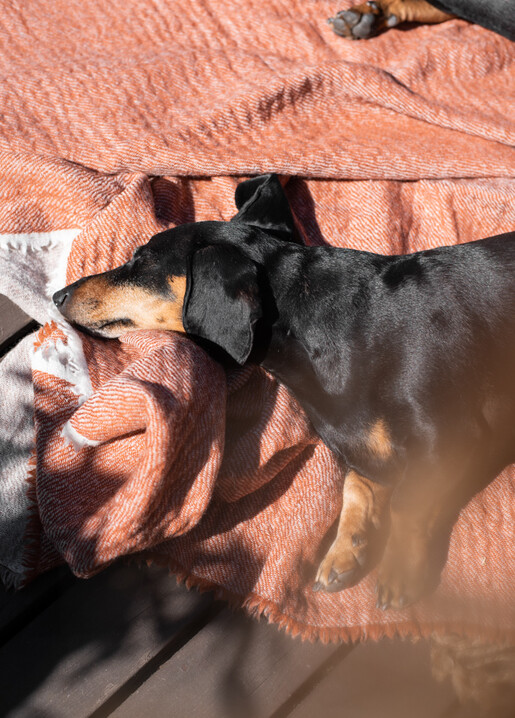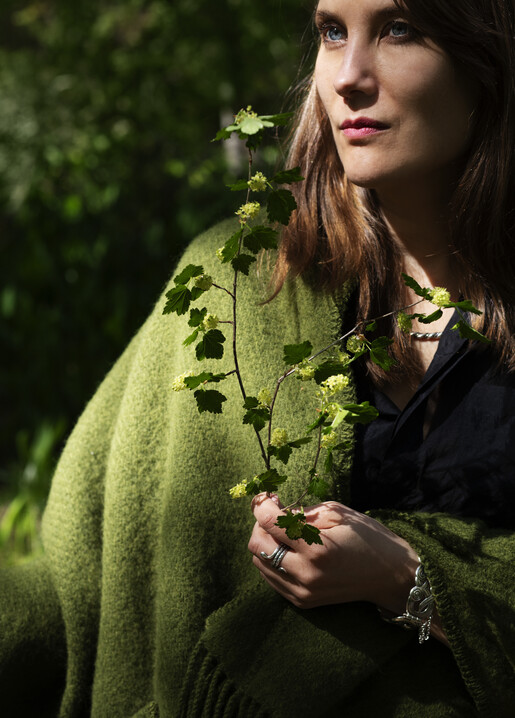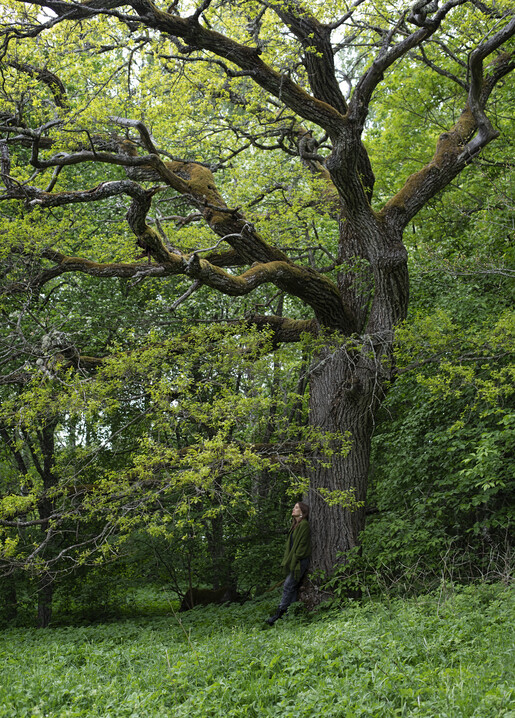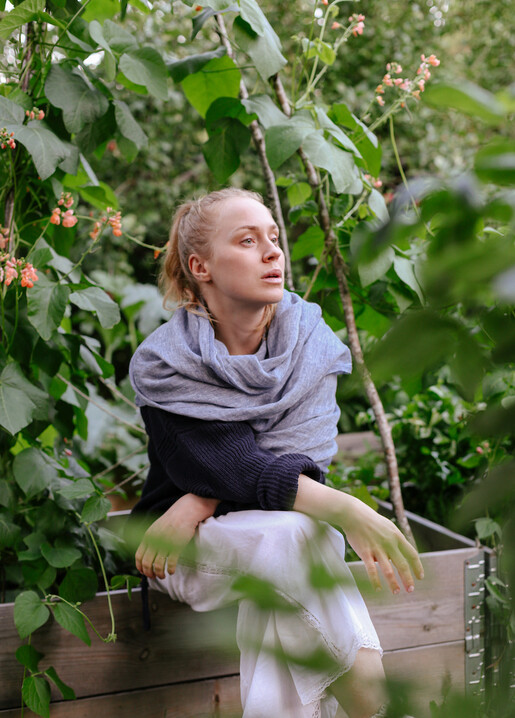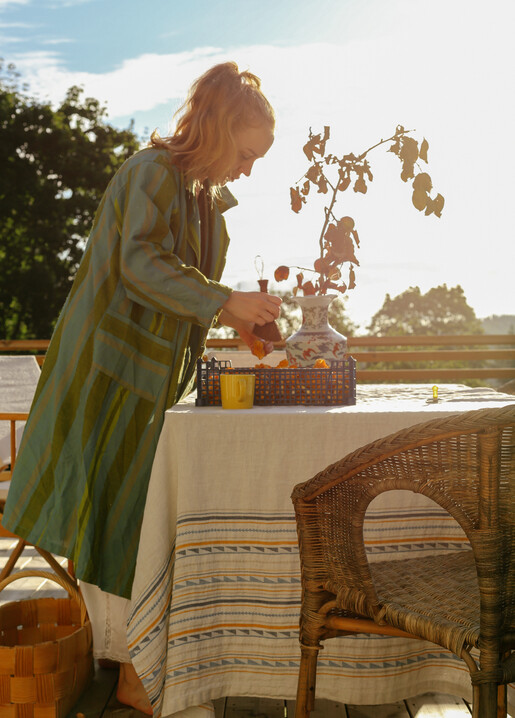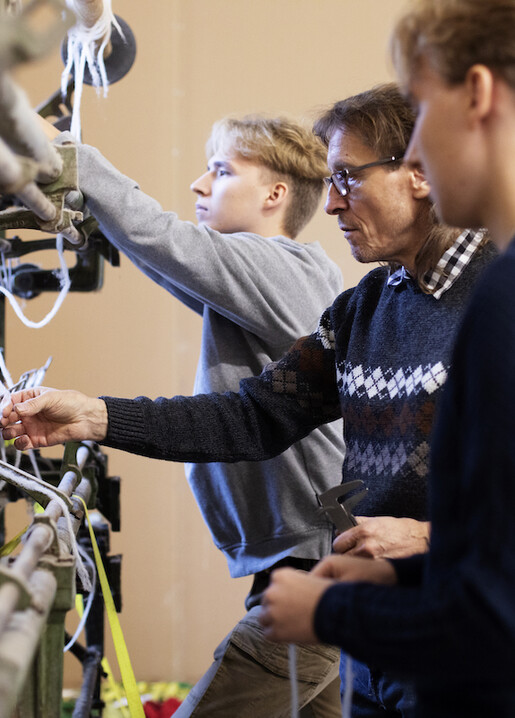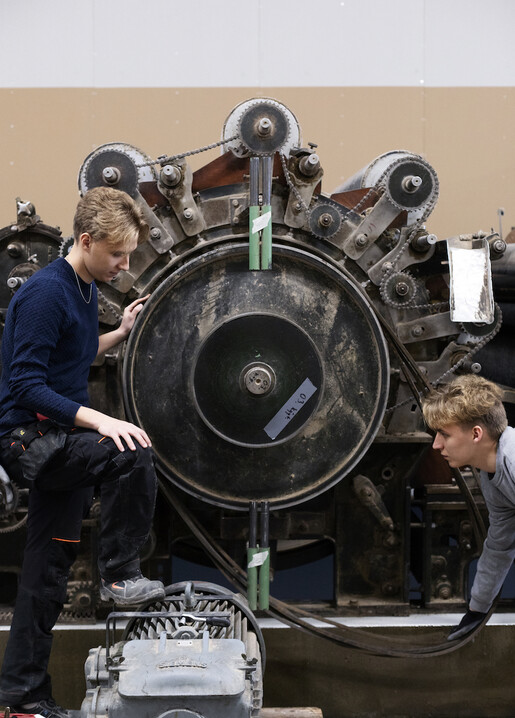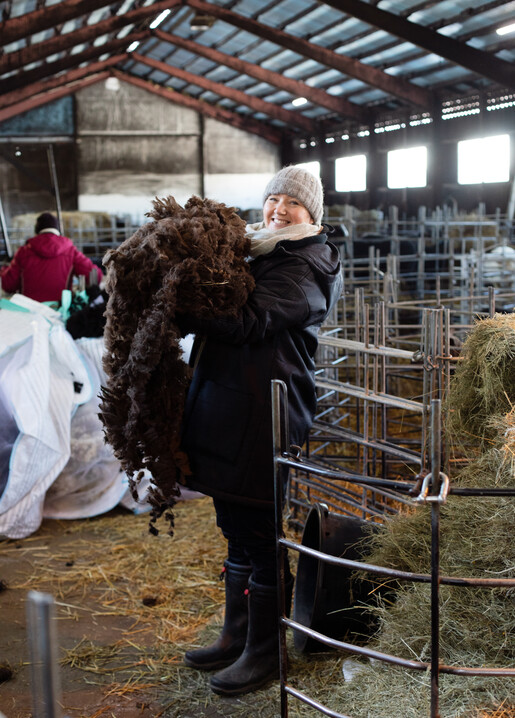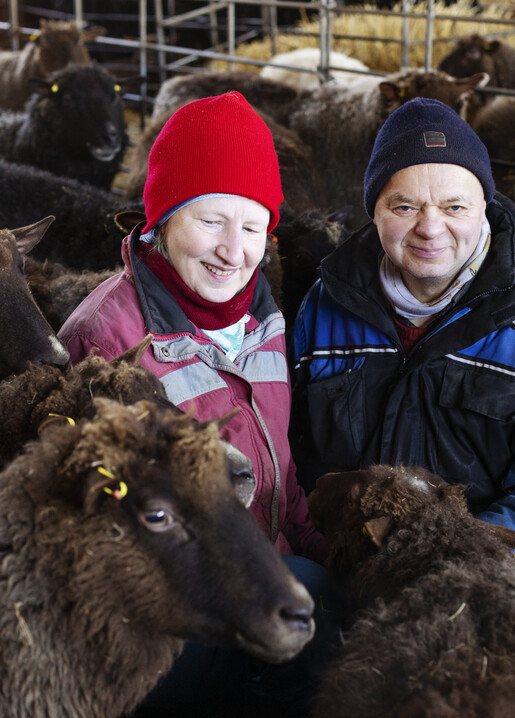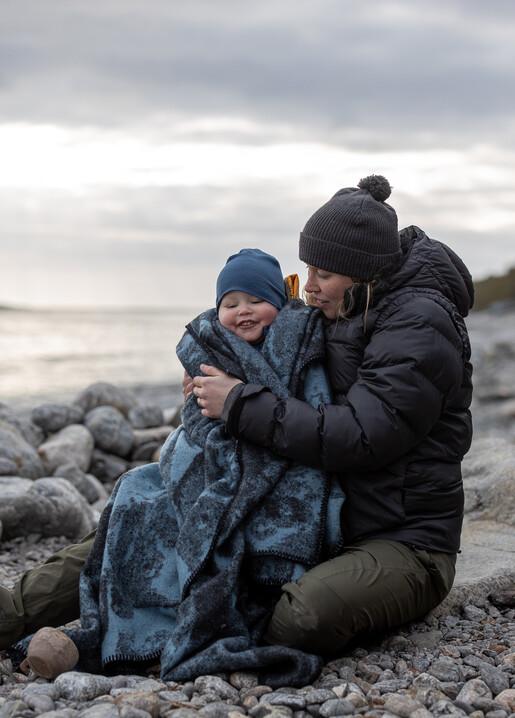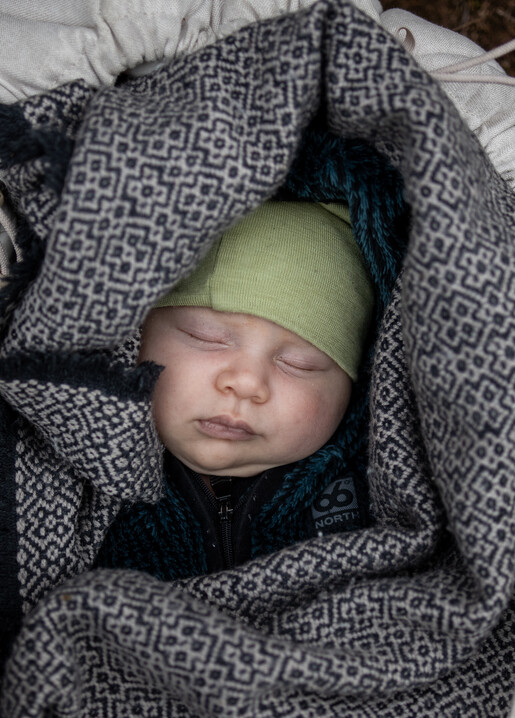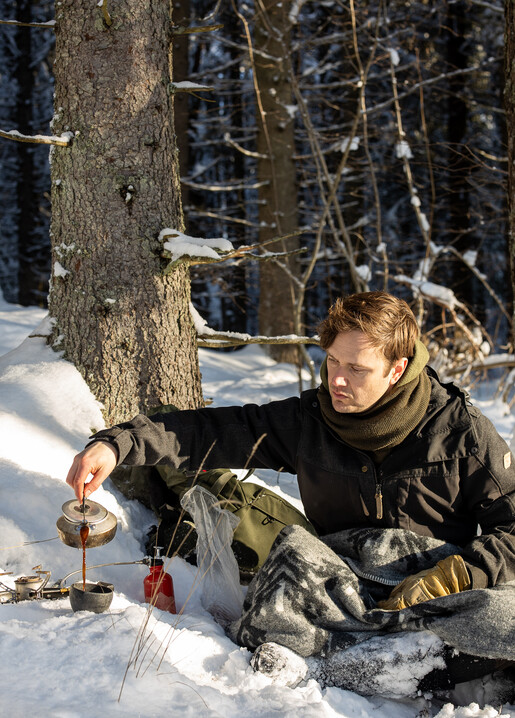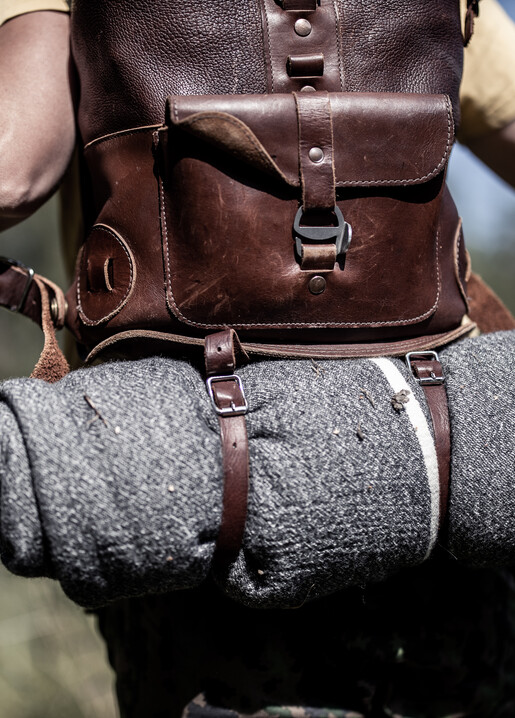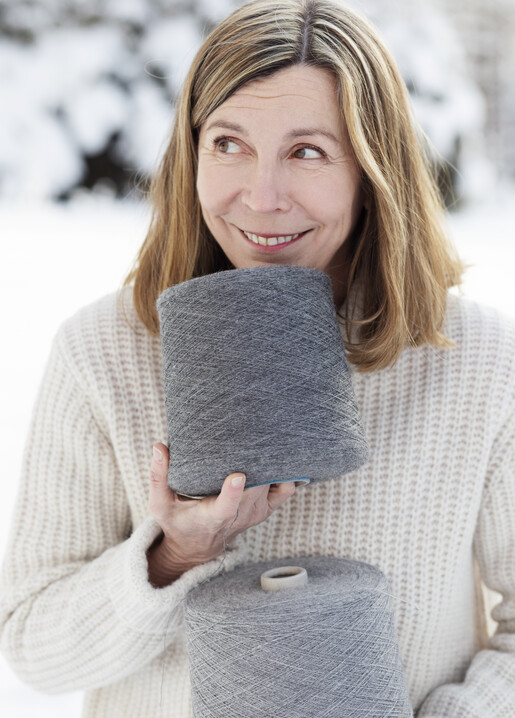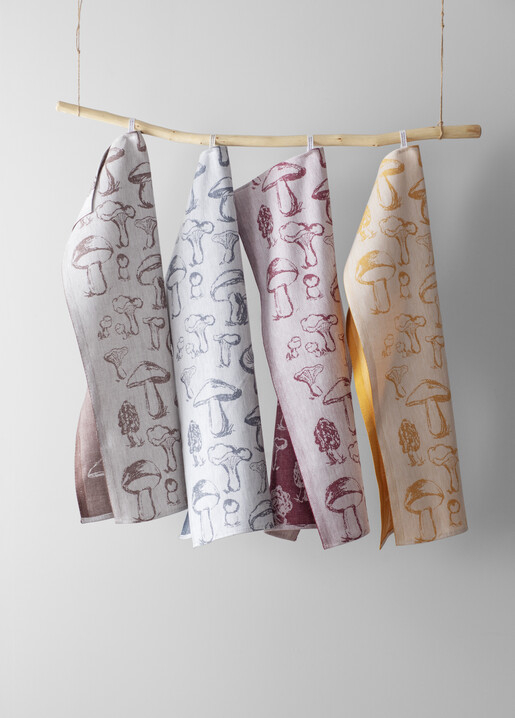INSPIRATION LIVES ON
Saara Obele joined f orce s with Lapuan Kankurit during her studies in the Aalto University through the PatternLab program in 2022. Her organic, unique style was an instant match for the brand. – It was very exciting for me to have Lapuan Kankurit as one of the first brands, if not the first, to take an interest in my designs. Not only was I already familiar with the brand, but I had also heard great things about working with them from other designers. Even though I was only a student at the time, I was immediately made to feel welcome with such warmth and respect. Working with them has had a great impact on my designer identity, Saara shares.
While her designs often draw from nature, Saara is also influenced by the people around her. For instance, her PUUTARHA design was inspired by her late mother-in-law, who was an enthusiastic gardener. – I believe that even though people will pass away, inspiration can live on. People who inspire us, and the lessons they’ve taught us, live on through our works and lives.
Saara’s new designs, PIHAPUU and TALVEN TUOKSUT, continue the visual stories she has been telling through her previous works for Lapuan Kankurit. TALVEN TUOKSUT is the aforementioned PUUTARHA design’s wintry sister, featuring traditional scents and flavours of Christmas such as spruce sprigs and orange slices. And whereas KUUTAMO was tropically themed, PIHAPUU is its more domestic counterpart with familiarly shaped leaves and plump berries. Both of the new designs emphasize Saara’s signature elements: a bold and expressive graphical style paired with lush colours.
As for her own inspirational legacy, Saara has two children whom she wishes to empower and encourage through example. – As I began my studies, it was important for me to show the kids that it is always possible to reach for your dreams, that you can work on yourself and learn new things endlessly. What you are doing now does not have to define what you are doing in ten years’ time. I have always been inspired by people who have the tenacity to push for what they want and for the life they wish to lead. It’s what I would encourage everyone to do: build a life that represents the genuine you. Make choices that stem from deep within yourself, not from someone else.
Text Jenna Suomela Photo Katja Lösönen
Talven Tuoksut runner and placemat | Lapuan Kankurit
Talven Tuoksut tea towel / napkin | Lapuan Kankurit
PIHAPUU blanket | Lapuan Kankurit
KUUTAMO blanket | Lapuan Kankurit
JÄKÄLÄ towel | Lapuan Kankurit
PUUTARHA towel | Lapuan Kankurit
THE BUTTERFLY EFFECT
It all started with a Finnish jacket. Akira Minagawa, known for his brand minä perhonen, had his life’s course changed forever after one innocuous purchase in Rovaniemi nearly four decades ago. The jacket he found in a local store became a symbol of the kind of designs Akira wanted to aim for: not high fashion, but quality craftsmanship for the everyday life.
– While walking alone in the extremely cold cities of Lapland, I was touched by the kindness of the people and learned about the beauty of everyday design, Akira reveals.
Akira’s style is often described with words such as romantic, naive and imaginative. Akira himself doesn’t submit to a particular style – to him, everything starts with his own memories, which he wishes to bring to life.
– I create with the feeling that I am bringing the fantasies in my mind out of my hands and into the real world.
Jaana Hjelt, the co-owner of Lapuan Kankurit, has admired the Japanese designer for years.
– As soon as we chose playfulness as this spring’s theme, mina perhonen came to my mind. His style fits perfectly with its cheery and colourful tones – it’s just what the world could
use more of right now.
Akira’s designs for Lapuan Kankurit, METSÄLAMPI and KESÄKUKKA are exactly that: whimsical designs full of colour and joy. The more abstract of the two, METSÄLAMPI (“forest pond”), which represents the Finnish landscape with its bountiful forests, mountains and bodies of water, was conceived a day before his visit to Lapua.
– For some reason, the picture of a forest and a lake divided into two parts, with straight lines representing trees and curved lines representing water, suddenly came to me. It was a coincidence that a simple picture of water gushing from a mountain came into being, but it was a moment that made my heart dance.
The gorgeous KESÄKUKKA (“summer flower”) is a testament to Akira’s wonderously vivid imagination. The design features an imaginary flower he painted while picturing it blooming casually and happily on the streets of Finland.
Both Akira and Jaana are happy with the collaboration.
– Good things cannot be created without trusting each other through empathy and respect. These are two important elements that have allowed us to quickly become comfortable with each other and trust each other. That makes me happy, Akira says. Jaana’s answer echoes with the same sentiments.
– We immediately felt a kinship with him, seeing how incredibly passionate he is about his work. As he said so himself after our first meeting: it feels like we’ve been friends for a long time already, she shares.
It has been many years since Akira’s first, fateful trip to Finland that started him on a path filled with awards, acclaimed collaborations and global renown. And still today, it is possible to pass Akira by in Finland, even perhaps while he’s waiting for a train to take him back to
Rovaniemi.
– Since the first visit Finland has been like home to me, and a place where I can always return to rest my mind.
Text Jenna Suomela Photo minä perhonen / Katja Lösönen
KESÄKUKKA linen tablecloth - blanket | Lapuan Kankurit
METSÄLAMPI towel | Lapuan Kankurit
PLAYFULNESS
“We don't stop playing because we grow old; we grow old because we stop playing.”
Our theme for spring of 2024 is playfulness. This spring we want to explore curiously, we want to frolic freely, we want to dance joyfully, we want to laugh with wild abandon. And, through our new collection, we want to bring all of this into your life, as well.
Let your imagination soar on the wings of a butterfly in the company of the Japanese designer mina perhonen and his new designs for us, METSÄLAMPI (“forest pond”) and KESÄKUKKA (“summer flower”). Marvel at the modernday magic of sauna with Kulttuurisauna’s Nene Tsuboi and Tuomas Toivonen. Explore our spring collection full of colour and whimsy and wonder.
We are introducing a new design by Elisa Defossez called HOHTO, “glow” in Finnish. The design is inspired by soft sunlight leaking through trees, commonly called “Komorebi” in Japanese. The striped pattern brings to mind the play of light through the leaves, as well as the gentle rhythm of the trees in forests.
We are also replenishing our collection with new colours and sizes for the following favourites: HALI, USVA, TSAVO, UNI, SAARI, OSMANKÄÄMI, KOODI, KOIVU and TERVA.
And beyond this catalogue? Let’s stay curious. Let’s try new things just from the joy of doing so, not to achieve something or to impress someone. Let’s do it because it makes the heart happy and the soul sing.
Let’s wander around and wonder at the world with wide eyes and an open heart.
Let’s stay young at heart together.
Text Jenna Suomela Photo Katja Lösönen
TERVA light linen-tencel towel | Lapuan Kankurit
OSMANKÄÄMI linen tablecloth - blanket | Lapuan Kankurit
THE ALCHEMY OF SAUNA
The ancient alchemists believed that by marrying together mythology, technology and philosophy, they would be able to perfect the human body and soul. Listening to Nene Tsuboi and Tuomas Toivonen, the co-owners of KULTTUURISAUNA, talk about the bathing experience, it’s clear that the two practices are not altogether dissimilar. The way they describe the transformative powers of heat and water in reverent tones, easily evokes the magical imagery of a great master labouring away to purify lead into gold.
A public sauna is like a shared contract or a promise you make with the other guests. You live in a city, you’re stressed from your work, you have all these things going on in your life – and then you come to this shared space, and you must respect the space and time of others as well. It’s a beautiful moment, when strangers share a harmonic moment through bathing, Nene says.
The purpose of bathing is to introduce a transformation through heat. At the end of the cycle of heat and cooling you have come through all kinds of changes, both physically and mentally. You’ve reached a new mental state, apart from the everyday, apart from business, apart from normal social hierarchies, Tuomas continues.
Creating that moment is no simple feat, as Tuomas and Nene can only offer the setting and the tools – it’s up to the bather to complete the ritual. There are rules both written and perceived, things you only learn by following others. – It’s both primitive and advanced. Sauna has a holy aspect to it, there are rules to it beyond the hygienic ones. It’s almost like an altar with a congregation that gathers, and there’s the gift of water you share as löyly, Tuomas describes.
One central tool in the ritual process of Kulttuurisauna, according to Nene and Tuomas, is linen. – We have hundreds of linen sauna covers here. Mangling is a significant part of our daily work, Tuomas laughs. – When you receive your sauna cover, locker key and a mug, you’ve taken your first step into the ritual.
Nene agrees. – The traditional sauna and linen go together perfectly. They have a shared history and theirproperties work well together. We couldn’t imagine using any other kind of material.
So, you’ve participated in the ritual of sauna. You’ve sat on the linen sauna cover, you’ve worked your body through the heat and your mind through the goings-on of your life. You’ve emerged from both the physical location and, perhaps, from something a bit more intangible. How does modern day alchemy present itself? Answers to that question are probably as numerous as sauna goers. Nene recalls the transformative forces of sauna with one customer interaction.
A guest tried to unlock her phone using the facial recognition feature after visiting us, without success, and exclaimed, “I must be so relaxed!” That’s the best kind of feedback for us. It’s both the challenge and the reward of our work, to offer this space of shared relaxation. When it all comes together, it’s magical.
Text Jenna Suomela Photo Bryan Saragosa
KAAPELITEHDAS long bathrobe | Lapuan Kankurit
TOFU PYTTIPANNU Á LA SAARA
The Indian spice mix adds an enjoyable surprise touch to the otherwise familiar taste of the dish.
2 garlic gloves
3 onions
2 tsp Indian spice mix
500 g potatoes
2 kale leaves
approx. 1,5 dl (0,6 cups) frozen funnel
chanterelles*
200 g tofu
canola oil for frying
salt
*You can also use dried funnel chanterelles.
Cut the potatoes into wedges. Wrap them up in aluminium foil and cook on the campfire for about 30 minutes. Meanwhile, cut the onions into half rings and dice the garlic gloves. Heat the oil in the pan and add the onions, garlic and the Indian spice mix. Sauté the onions to the point of caramelizing. Check the potatoes; if they aren’t ready yet, take the onions off the heat. When the potato wedges have cooked, add them to the pan. Tear the kale leaves into tinier pieces and add them to the mix together with the funnel chanterelles. Crumble the tofu into the mix as well. Fry the mix until potatoes have achieved a satisfactory colour and everything has heated up.
Viimeistä murua myöten - Ruokablogi (viimeistamuruamyoten.com)
DEAR WORLD OF 2073
We hope you are doing well.
As we are celebrating the 50th anniversary of Lapuan Kankurit, it feels proper to not only gaze back to the past half a century, but to also set our sights on to you, the world of tomorrow. After all, it is for you that we do so much of what we do. Investing in education. Developing new ways to consume less and to give out more. Forever exploring new avenues to be kinder, gentler, less demanding on our environment.
We hope that kindness, in general, has prevailed. Sometimes we fear it won’t be so. We hope to have learned the very difficult and exceedingly obvious truth, that tearing each other – and this planet with us – down will always do us less good than building each other up.
We know that the future is impossible to predict. Nobody can really say what is to come. But this we know: while we will keep evolving, keep renewing, keep innovating, our core values will stay the same. The intelligence of nature and the invincible characteristics of natural materials will be the same. Mother Nature is the most ingenious engineer of all, and we will do well to keep learning under her tutelage.
So, world of tomorrow. Here they are. Our fragile hopes for you, our fierce dreams. We will bury them into the soil and raise them up to the skies. Sow them within every sewn thread, weave them into every yarn. Manifest them into being in the form of our labour and love.Dear world of 2073, we hope you are doing well. And in the meanwhile, we will be doing everything in our power to make it so.
Text Jenna Suomela Photo Katja Lösönen
BACK TO THE ROOTS
I sip on pot coffee from the depths of my memory-soaked guksi. With it I am enjoying some home-made, freshly baked cinnamon rolls, as is appropriate.
Wandering in the nature has been my favourite pastime ever since I was a child. I love following the changing of the seasons, especially autumn’s swift retreat into hibernation, the descend of the first snow, soon followed by the fresh growth reaching up under the white blankets in springtime. In the embrace of the outdoors the mind unwinds, and we gain new perspective on everything. Add some delicious food to the outing, preferably shared with someone, and you have found the recipe to happiness.
Good food, whether brought from home or cooked outdoors, turns an outing into a true trek.
Cooking food outdoors, especially on a campfire, is not a hurried person’s activity. It takes patience. Chopping logs, cutting them up and shaving off pieces of tinder. Lighting them up, waiting patiently for the food to cook in the warmth of the flames. I guess part of the magic of outdoors food is that it forces you to sit down and let things take their required time. While waiting for the food you can just let yourself be. Don’t have to answer to a couple of more e-mails, and the thought of scrolling through the social media feed doesn’t even cross the mind.
The senses awaken. You notice the silvery shades of a deadwood. How the lines on the pine bark crisscross, each in their own, unique directions. You sense the surrounding sounds and scents – or the lack of them. The thick blankets of midwinter bury everything fragrant under frost and crown snow-load, silencing the rustles and swishes of trees. How wondrous it feels when nature starts brimming with scents again in the late winter and early spring. The resin of conifer needles, the pure water revealing itself under a sheet of ice. When you hear the birds singing and a stream murmuring.
There’s rarely time to just be, even if staying still is exactly what I notice I’ve been missing. The forest wipes the mind clean and lifts a smile on the lips. Where would I have been rushing to, anyway?
After the potatoes have roasted on the campfire it is time to continue cooking. Onions, spices, kale, dried funnel chanterelles that I collected in the autumn as well as some tofu make their way on to the pan. The rest goes by quickly. Indian tofu and funnel chanterelle scramble is ready. I spread a blanket on the glittering, frost-hardened snow in the middle of a white birch forest. I focus on the flavours while I eat, enjoying myself. The simple ingredients have developed a smoky aroma from the campfire. That alone is reason enough to enjoy a dinner out in the woods.
For me, life’s luxuries mean being able to live so close to mires, beautiful forests and rustic leantos with their campfires that one can visit them even during weekdays after work. Even greater luxury is to gather the edible treasures of nature during the late summer and autumn, all the way up to the frost-bitten cranberries. The preserved colours and flavours of nature bring joy to the long winter. Nothing tops a bowl of oatmeal with honey, cinnamon and golden cloudberries.
I’ve always said that I don’t need my own yard or a cottage.For me, nature is the place I can retreat to, relax in and where I can prepare delicious food.
Text & Photo Saara Atula
CHANGE CREATES CHANCES
The last few years have brought tremendous changes into the life of Samu-Jussi Koski. He parted ways with his brand, Samuji, to focus on designing smaller collections for Finnish companies, and to discover what other possibilities life would have in store. One such avenue, costuming theatre productions for the Helsinki City Theatre, is what brought SamuJussi and Lapuan Kankurit together.
– I’ve held a deep admiration for Lapuan Kankurit for the longest time. I had met Jaana during my time in Samuji. Though we had talked about working together, the idea truly gained momentum when we met by chance when she came to see a theatre production I had designed the costumes for, Samu-Jussi shares.
Jaana Hjelt, the co-owner of Lapuan Kankurit, remembers the night well. – I spent the whole musical admiring the enchantingly simplistic costuming, becoming surer by the second that we simply had to work together. We agreed to meet up afterwards, and soon enough Samu-Jussi was touring our production line in Lapua. From the beginning it felt like we had a connection, an ease with which we cooperate. We all respect each other’s expertise, and this is the key to a fruitful collaboration.
The chance to try his hand at creating textile patterns was welcomed by the self-processed “eternally curious” Samu-Jussi. – The thing that inspires me the most in this line of work is novelty. I’m forever driven to experience new things, to create something unique. Still, the goal is always the same. I consciously avoid following trends and, instead, aim to create beautiful everyday products that people can actually use and feel good about.
According to Samu-Jussi, a collaboration with Lapuan Kankurit felt natural due to their shared values and mindset. The interest in fashion that drove him to pursue his chosen career has, with time, developed into a true reverence for sustainable, beautiful, highquality designs that stands the test of time both in quality and style. – The material is the key. I am endlessly inspired by the possibilities of the material I’m working with.
The collection with Lapuan Kankurit was born from the love Samu-Jussi has for the capital city of Finland. It’s both an ode to his beloved Helsinki as well as the ideal of it. The designs, called TÖÖLÖ, MERIHAKA, KAAPELITEHDAS and HIETSU, named after important districts and neighbourhoods, play around with the scales and proportions of the windows and architecture of the city that holds a dear place in Samu-Jussi’s heart.
And what chances might tomorrow bring? – I’d love to collaborate more with Lapuan Kankurit. Beyond that, I hope that we, as a society, keep progressing in a more mindful direction and don’t regress. I welcome the change we have witnessed in the past years in our industry, how nowadays the quality and origin of your chosen materials genuinely matter. I must keep faith that, ultimately, we understand what’s best for our world. In this Lapuan Kankurit is the true forerunner, who keeps creating change for the benefit of us all.
Text Jenna Suomela Photo Viola Virtamo
TÖÖLÖ blanket | Lapuan Kankurit
HIETSU towel | Lapuan Kankurit
MERIHAKA linen tunic | Lapuan Kankurit
MERIHAKA linen shorts | Lapuan Kankurit
MERIHAKA linen pants | Lapuan Kankurit
MERIHAKA linen shirt | Lapuan Kankurit
MERIHAKA scarf | Lapuan Kankurit
KAAPELITEHDAS linen bathrobe | Lapuan Kankurit
WHAT THE MIRES WOULD TELL US?
What would the mires tell us if they had a voice? Perhaps they would whisper about the secret gatherings of the golden cloudberries, hiding where only the worthy may find them. Maybe they would sigh about the gentle caress of a twig of a shrub on your ankle, as a tuffet of moss gives way. Or maybe they would ask to share with you a moment in the peace of a pure spring fen, watching as the swirls form ever-changing patterns. Mires do not guard their secrets jealously. They share generously with anyone who wishes to lend an ear.
Unfortunately, many of the Finnish mires have been silenced, as over a half of the original areas have been drained. In cooperation with the The Finnish Association for Nature Conservation and with the help of the designer Marianne Huotari, Lapuan Kankurit has created the VOICE OF THE MIRE collection to answer our precious wetlands’ cry for help.
Mires mean a lot to Marianne. Her parents are from Kainuu, and she spent the summers of her childhood gathering berries and fishing in the mire areas. To her, they speak of home. When Marianne was asked to design a collection to help raise funds for them, inspiration came instantly. – I wanted to let the mires tell their own story, with their own voice. All the designs in the collection came to life by using the mire plants as brushes: it was the mosses, brush twigs and small pine cones that painted the gentle lines on the paper. I felt that my mission here was to be the messenger, Marianne says. – We need bold and loud discourse to protect the mires, and the colours and the designs of the collection reflect that.
Perhaps, what the mires would tell us is that they need help. That they are doing their best, but they can’t do it alone.
Text Jenna Suomela Photo Katja Lösönen
The essentiality of freedom
When speaking with Matti Pikkujämsä, it does not take long for the value of freedom to come up in the conversation. From the liberty of a freelancer to choose the projects that inspire him, to finding inspiration from anywhere and anything, it is clear that to Matti, rigid structures and definitions appear stifling. This desire to evade boundaries carries on to his self-concept. – I trust that my style is strong and recognizable enough that I don’t have to limit myself to one particular look or method and can, instead, explore new avenues fearlessly. Still, the heart of it all remains the same. I started out with illustrations for magazines and children’s books, and that’s where I’d trace the nostalgic and somewhat naïve feel of my works, Matti says.
To Matti, inspiration can appear from completely unexpected sources. – I’ve found that I’m easily inspired, and that inspiration can strike completely out of the blue, Matti reveals. To satisfy his curiosity for new avenues of inspiration, Matti collects anything from books to Pinterest boards. Inspiration is not bound to the medium for him – a new idea for a magazine illustration can begin with a fabric pattern.
Like his inspiration, Matti’s relationship with Lapuan Kankurit originates from an unexpected source. The acquaintance was made through a common friend from Japan while Lapuan Kankurit was looking for a new sauna product design. Thus were conceived both the MIESTEN SAUNA and NAISTEN SAUNA designs, as well as the 10-year-long working relationship between Lapuan Kankurit and Matti. – I enjoy working with them tremendously. Lapuan Kankurit places a lot of trust in their designers, allowing me to work freely, which I find essential. I’m also free to focus on the design itself, as I can count on the quality of the product from the start. I’m proud that I can call them my clients, says Matti.
Matti’s newest design for Lapuan Kankurit, VERANTA, found inspiration in the atmosphere of a grandma’s home, with ceramic vases filled with hand-picked flowers, together with the graphic style of 40’s and 50’s. – I wanted it to be familiar yet exciting, combining elements of old and new. I challenged myself to make blackand-white feel colourful, to make the viewer imagine colours in the design, Matti describes.
As for the future? Unsurprisingly, it has a lot to do with freedom. – I’ll keep finding inspiration in the new things Lapuan Kankurit comes up with – their innovations are endlessly exhilarating. Besides that, I wish to continue working freely, not knowing where I will end up or what I will end up making. I think it’s a very comforting thought, not knowing. Turns the future into a great, big adventure.
Text Jenna Suomela Photo Teemu Silván
Respecting the past, weaving the future
A lot has changed for Lapuan Kankurit in their fifty years of business. And yet, to the owner Esko Hjelt, much more remains the same way it always has been. – Our family’s textile legacy began when Juho Annala founded a felt boot factory in Lapua in 1917. His grandson, Juha Hjelt, started his own weaving mill with his wife Liisa in 1973, naming it Lapuan Kankurit.
The core business concept has remained the same ever since. To this day, we utilize the same techniques to make traditional jacquard-woven products. We are a family business with values to match, and the concept of family extends to our employees. We focus on human-sized production scale, so that the entire chain is traceable, and the bare minimum is going to waste. Juha saw that there was little future for mass-scale production in Finland and found Lapuan Kankurit to focus on special items in smaller quantities. This is still the way we operate.
Breakthroughs in technology have seen improvements in production efficiency and quality. Before electrification, jacquard weaving machines required paper cards to produce a desired pattern, and bigger patterns required more paper, with considerable size limitations. Nowadays patterns are designed and executed with the help of computers, allowing for near-limitless sizes, patterns and colour combinations. The quality control of fabrics has also been perfected with technological advancements.
Ever the trailblazers, the visionaries of Lapuan Kankurit have not been satisfied with solely improving upon the old. They have also trekked on new-found areas of expertise – or more aptly, areas which have been found anew. – We are taking steps to incorporate plant dyes into our production cycle and have made heavy investments to build our own finishing plant and spinning mill for Finnish sheep wool products. A lot of these crafts and knowhow vanished from Finland altogether for a time.
Our aim is to not only bring these traditions back to life, but to also bring them to the 21st century with developed techniques and advanced machinery, says Jaana Hjelt.
Though the heart of Lapuan Kankurit has remained the same since Juha Hjelt’s time, each new generation has brought something new to the midst. – Juha and Liisa had their own dreams for the company. For Esko and Jaana, the dream today is to focus on the future: what we leave behind for the future generations, what is required to keep doing what we are doing in the future and how to do it with the environment in mind.
We take matters of responsibility, circular economy, locality and the sourcing of materials seriously. This is why we invest in things such as Finnish sheep’s wool, plant dyes and education – it’s all investing in the future. We may not see short-term profits with these actions, but hopefully, in 10 or 20 years’ time, the results will speak for themselves.
Immersed in nature
I wake up when the rest of the house is still sound asleep. The soft breathing of dreaming children can be heard in the otherwise quiet house. Dressed only in my emerald green swimsuit and linen bathrobe, I close the door silently behind me. Barefoot, I walk down to the beach. It is a calm, grey morning, which adds to the stillness. The birds sing in a more mellow tune and the trees have nothing to tell me.
Mornings by the beach are usually busy. There are many of us who like to start our day with a swim. Wet footsteps on the wooden dock tell me I am not the first here this morning, although right now I am alone. I leave my towel and bathrobe on the railing and let myself merge with the grey water. The morning mist erases the horizon, making the totally calm sea float together with the grey sky. From my waterbug perspective, the mallards seem elevated in the air. I try to swim without making too much noise, so as to not disturb the awakening of nature – although I am aware that from the birds’ point of view, it is already late in the day.
For me, my morning swim is both a meditative and a physical exercise. I take it slowly and every now and then I take a break by floating on my back like a starfish, gazing up at the sky. Glimpses of blue sky are starting to show, birds fly high in the air. I simply lie there and feel totally immersed in nature. I let myself be mesmerised by mysteries that are not for me to solve, but to belong to.
When I return to the shore I am greeted by a smiling old man, standing with a gracefully aged linen terry towel on his shoulders, clogs on his feet. He has not yet been refreshed by the sea and asks me how the algae situation is this morning. “Not too bad,” I answer, and we both acknowledge how privileged we are to live by a clean sea – something we have learnt not to take for granted. Numerous are the mornings when the surface has been painted in thick green, matching my emerald swimsuit, and I must postpone my dawn dip until the wind changes and carries the algae further out to open waters. The smiling old man must have noticed that our conversation has brought a sadness upon me, so he points out that he has observed a noticeable improvement in the last few years – the water is clearer and the bladderwrack has returned. “Remember, life is beautiful,” he says, before he dives gracefully into the sea.
Text Sara Bengts Photo Teemu Silván
The lessons in laziness taught by the garden
The atmosphere reminded me of a secret garden in a nostalgic resort village. An atmosphere that, to me, seemed to suggest a more resort-like and relaxing living.It seemed to me that, living in a place like this, life itself would become more easygoing and relaxed. We made massive renovations in the ramshackle apartment while trying to preserve as much of the original surfaces as we could. Luckily, we were able to spare the old oak-paneled ceiling and most of the original oak parquet. We also kept the old folding doors, which at first were considered hideous by everyone else. Now they garner only admiration, and no wonder – they fit seamlessly with the architecture and the atmosphere. The garden itself has been left to its own devices for now. This is due to a tip we received from those in the know: before making any major changes yourself, it’s wise to first observe the garden’s own way of living. To see what grows from the ground and when things bloom. What a lesson to learn for two impatient people, that sometimes the best thing you can do is to do nothing. In my mind, the secret garden is teaching us how to be lazy and enjoy the moment instead of always living in the ideas and hopes of the future.
You can tell that, once upon a time, the garden was tended to with great love and care. The groundwork is immaculate, everything has been carefully thought through. Even though the garden has not been maintained in many years, the flowers still bloom one by one in the same exact order as they always have. My absolute favorite plant is the enormous rhododendron growing under the window of the dining space, with its ambient shadows cast both inside the house as well as on the terrace. The last rays of the setting sun filter through its branches during the evening. I also adore the azalea, the early summer’s blossomer, the Amur maple which dresses in red during the autumn, as well as the small Japanese succulent garden, which is rather sympathetic in all its disrepair. The small yard has brought more to our lives than we ever could have guessed. It feels like an additional room which opens in the springtime with the melting of the snow. Every activity we can, we do outside: drink the morning coffee, eat lunch, read books, cool off after sauna. If it’s raining, we achieve all of this under the awning. Sometimes I even write under its shade. The dog sisters adore the yard at least as much as we do, most likely considerably more. They sneak around amidst the ferns, romp on the lawn, play together and chase after balls. Lolling in the sun is the favorite pastime for them both. In a way, I do think we chose this home with them in mind specifically. They enjoy the yard equally during the winter: last spring Jarno made a great labyrinth for them in a snowbank. Other animals that enjoy our garden include birds, squirrels and lazily buzzing bumble bees. I could spend hours just sitting there and watching them go about their lives. There is a rather hideous old birdbath in the garden, which has proven too popular among our feathered friends to get rid of. The outdoor furniture consists of only flea market finds, as does most of the furnishing in general. We have a great affinity for wood, rattan and other natural materials, which only improve in use. The patina of time and use should shine through. High quality textiles such as linen only become more beautiful with each wash. We do not plan our interior design in painstaking detail, but rather choose items that catch our fancy and trust that, in some magical way, they will all come together in the end. This brings out the most unexpected and mirthful of contrasts. I have a particular appreciation for objects meant for utility but designed with taste. When the things we use daily please the eye enough, there really is no need to spend surplus time doing actual decorating.
Text Stella Harasek - Photo Stella Harasek, Jarno Jussila, Mikko Rasila
AAMU tablecloth | Lapuan Kankurit, JÄKÄLÄ blanket | Lapuan Kankurit, DUETTO blanket | Lapuan Kankurit, KOLI scarf | Lapuan Kankurit, JÄKÄLÄ towel | Lapuan Kankurit
Through the eyes of tradition
Katja Lösönen has worked with Lapuan Kankurit for nearly 13 years as a masterful storyteller through her words and pictures. Originally hailing from the countryside of eastern Finland, she left the bustling life of Helsinki behind to relocate in the coastal city of Vaasa, the regional capital of Osthrobotnia. She has come to enjoy and appreciate the area, especially the Ostrobothnian way of living and being.
People here care about one another and have a very sure sincerity about them – qualities which I also recognize in Lapuan Kankurit itself.
Katja traces her roots deep into the Finnish Karelia, well known for its rich folklore and tradition. She finds her heritage to be an important part of her selfhood, both in her professional and private life.
I do feel a responsibility to protect and uphold not only our folk religion and traditions but also our native forests and their biodiversity, Katja says.
Nature is an intrinsic part of our culture. And personally, I do believe in the holiness of nature itself. To me it seems strange how distant nature has become for many – something to pay for and travel to over a holiday – when it could be something present and near in the everyday life.
Her core philosophies and beliefs are an essential part of her work as well.
I enjoy working with companies whose values and ideals match with mine, says Katja.
This is one of the reasons why I’ve enjoyed my time with Lapuan Kankurit so much: we share the values of sustainability, respecting our legacies as well as nature-focused and nature-appreciative living. There is something very true-to-life and authentic about Lapuan Kankurit and the work they do, something that reaches past the surface.
The sentiment of values is echoed by the owners of Lapuan Kankurit.
I take great pride in the fact that I’ve been surrounded by a group of people who dedicate themselves to Lapuan Kankurit marketing with utmost joy, professionalism and passion. The secret to our long-standing partnership with Katja is definitely in our shared values and way of thinking. She always seems to know just what we are looking for in our photos and has brilliant ideas. Katja has a near-magical ability of bringing nature and its ambiance palpably to us through her work, says Jaana Hjelt.
In every story Katja has created for Lapuan Kankurit we are invited to perceive the world through her eyes – the view anchored in deeprooted heritage, steady values and a tangible affection for the Finnish forests and their many myths.
I adore my line of work. It is humane and appreciative at its core. You do not have to strive for something perfect, but rather for something genuine and captivating, Katja says.
Text Jenna Suomela & Photo Katja Lösönen
All the mistakes I've made: Garden
Our society doesn’t really love mistakes. It’s ok to have minor mishaps, but you should always try to quickly redeem yourself, learn from your errors, try again — and succeed.
But just to try something out for fun, with little regard for the perfect outcome? It’s pretty rebellious!
Our work lives leave us with very little room for errors. It’s not really professional to experiment with your career. Also, a significant portion of hobbies, especially sports, aim for competitions or have some kind of measuring system for whether you are doing it right or not.
And of course, so does gardening. There are competitions, and I’m sure no one ever plants anything, not hoping to succeed. But whenever I talk to people who enjoy gardening, they all have recent stories of failed cucumbers or weird diseases attacking their potatoes.
And that’s ok! Everyone expects it. A big part of gardening is trying things out, sometimes knowing that your chances of success are slim. This year I tried tomatillos, fully aware that the climate in Finland would probably prove to be a challenge to this small green tomato, native to Mexico. And so it has: we achieved lots of blooms, but no fruit.
I have planted and re-planted all my 55 peonies many times. I won’t go into detail as to why, but let’s just say that I now believe people who are more experienced than I am when it comes to instructions on peony planting.
I’ve definitely had some triumphs too. This summer, I planted zucchinis in the herb garden, and it has been a great success. It has produced an abundance of cucumbers all summer.
To me, this is why I love gardening. It’s not serious. Of course, it’s fun when something goes really well, but there is always room for experiments, and if something is not working, it’s ok to decide: I give up; this is not for me. I don’t think I will try tomatillos again, but I am tempted to try melons or grapes!
In the meantime, whether the melons or grapes or tomatillos ever work out, I’ve spent hundreds of hours feeling joy just thinking about new things to plant. I have celebrated surprise cucumbers and blooming peonies. It’s a hobby that teaches you to nurture and to be patient, and really to re-evaluate what failure even is.
Text & Photo Kirsikka Simberg
Read more: Way of Living SS2022
Master Class of Spinning
In the very heart of Lapuan Kankurit, there is the desire to maintain and develop traditional weaving skills and culture and bring them to modern times. In 2022, our own wool spinning mill and finishing facility will be completed and we’ll be able to have practical use of the local sheep’s wool. We are assisted by experienced masters, like Rainer Koivula, who has been working with textiles for almost 50 years. In autumn 2021, Rainer Koivula transferred the wool spinning machines from the former Suupohjan Kehruutehdas spinning facility to the new wool spinning mill of Lapuan Kankurit. This may sound like a simple project, but there is much more to it. The wool carding and the spinning machine are both over 20 metres in length and tons in weight. Rainer has pulled down the equipment piece by piece. Then the pieces have been loaded in a truck and moved 100km distance to Lapua.
In Lapua, the 19-year-old twins Eero and Elias Hjelt who’s family entrepreneuship Lapuan Kankurit is, have cleaned the machine parts alongside their studies, and have also learned a lot, when Rainer Koivula has reassembled the machines back to working condition. “The work is physically hard and challenging, as the entity is so large. But the meaningfulness of the work beats the stressfulness, because it is such a positive thing that an initiative like this exists”, says Rainer. Now that Lapuan Kankurit starts to manufacture wool yarn of local sheep’s wool, we will have more of the textile industry back in Finland, where it had already disappeared. Here, we have the opportunity to make good use of the Finnsheep’s wool that would otherwise partly go to waste. “The project has been demanding. It has involved building two manufacturing facilities, procurement of new equipment and modernising of old. As well as gathering responsible wool from local farms, experiments with plant dyeing and taking the circular economy and then ecological aspects into account in every step of the way. The project wouldn’t work out without the knowhow of Rainer Koivula. It is something many of us don’t have anymore.
Rainer started working in in the textile industry when he was under twenty years old, working for a loom tackler in Vaasa cotton factory. After that, he has had a decades’ career in weaving mills, as a machine technician and as a weaving mill entrepreneur. “It feels good that the old method is renewed. While we deal with traditional method, we can do things in a new way”, says Rainer. Rainer’s colleagues appreciate especially his attitude. When technical problems or other issues come in his way, Rainer amiably states: “Things always have a way of working themselves out.” The new wool spinning mill and finishing facility of Lapuan Kankurit will be completed during the year 2022. In 2022-2023, the first products weaved with Finnsheep’s wool yarn will be ready to be introduced to our customers. The products are a combination of traditional wool knowhow and modern design. “I have hoped that an era like this would come. That the local sheep’s wool would be highlighted. It will become again a tangible part of people’s everyday life, close to us people”, Rainer says.
Text Tia Nikkinen photos Katja Lösönen
Read more: Way of Living SS2022
Investing in high-quality Finnsheep wool
Text & Photo Katja Lösönen
The atmosphere in the sheep barn of Reino and Raija Louko is peaceful. Only a stray bleat blends in with the even buzzing of the shears. The brown, black, and white Finnsheep curiously peak at the shearing line where the shearer handles the sheep with a steady grip. The wool shorn here will end up at the weaving mill of Lapuan Kankurit a few miles away, where it will be transformed into high-quality Finnish design.
At the Louko sheep farm, the biannual shearing of the Finnsheep is in full gear. The shearer flips the sheep into a seating position, and the shearing process only takes the experienced professional a couple of minutes. The peaceful sheep are keeping still, apparently enjoying the shearing. “We use the best shearers in Finland to ensure we get the highest quality wool, while also making sure the sheep are not harmed in any way,” says Reino Louko.
The Finnsheep is an original Finnish breed, typically white, black, or brown in colour. “By its nature, the Finnsheep is friendly and very curious,” says Raija Louko. “They want to take part in everything, and each one has its own personality.”
From the wool produced in Finland, only around half is used, which means that a large part of the wool goes to waste. The main reason for the poor utilisation rate is the low price of raw wool, which has not encouraged sheep farmers to undertake the laborious tasks of sorting and selling the wool. “Once demand increases, the price of wool fibre will go up. Our starting point is making it profitable for the sheep farmers to collect and sort their wool,” says Esko Hjelt.
Lapuan Kankurit has accepted the challenge by making large investments in the utilisation of Finnish wool. Esko Hjelt has visited many sheep farms to collect wool and create a supplier network of wool producers. In the production facility in Lapua, new Jacquard weaving looms have been installed, and building a unique wooltextile finishing facility in Finland has started. In total, this is a two million-euro investment.
“Using domestic wool is another tangible step towards even more sustainable production,” says Esko Hjelt. “It also means that we get to weave top-quality wool. Especially the wool from Finnsheep is exceptionally soft, easy to felt, and has a beautiful sheen.”
The first batches of wool have been washed in England because as of now, industrial-scale washing is not possible in Finland. Once washed and back in Finland, the wool is spun into yarn. Methods are also being developed to utilise natural dyes. Finally, the yarn is woven and finished into wool blanket. “We are rebuilding a production line that had previously disappeared from Finland,” says Esko Hjelt.
He adds that consumer demand plays a great part in the use of domestic raw materials. “The consumers’ interest in the origin of raw materials and sustainable production has grown, so we are relying on that our highquality products made from Finnish wool will find their way into homes near and far.”
The versatile wool blanket
Text & Photo Anton Kalland
At its most simple and yet versatile, the wool blanket brings out the best properties of wool outdoors. Ever since humans domesticated sheep 8000 years ago, the wool blanket has retained its shape up to this day. The super-functional properties of wool woven into a square shape makes it the ultimate piece of equipment for adventure.
1. The wool blanket can be worn while resting. During a lunch break or sitting by the campfire you can wrap the blanket around your shoulders, and if you pull your knees up towards your belly underneath the blanket you can also make use of the heat released from the big arteries in your thigh muscles. You can sit on the edge of the blanket to protect yourself from the cold seeping up from the ground.
2. When sleeping in a tent in below zero temperatures, you can spread a wool blanket on top of your sleeping bag to prevent moisture from getting caught in its insulation. Some of the moisture that leaves your body when you sleep will be caught by the blanket so that you can shake of the crystals the next morning. There is no way to remove frozen moisture from the insulation of a sleeping bag in outdoor conditions. After a night in the tent, you can easily remove the frost inside the tent with the wool blanket.
3. By placing a wool blanket on top of your sleeping pad, you will be better insulated from the cold in the ground. Contrary to the down of the sleeping bag, wool does not lose its insulating properties when compressed. Sleeping pads filled with air often make a squeaky noise against the synthetic fabrics of the sleeping bag, whereas wool reduces noise.
4. Wool protects you from sparks. When sitting by the campfire you are often wearing hiking clothes made from synthetic materials and sparks will burn holes in them. You can avoid sparks by selecting the right type of firewood, for instance by avoiding spruce branches and logs. By wrapping yourself in a wool blanket, you are protected from sparks as wool is less sensitive to them.
5. You can use the wool blanket as a makeshift for carrying things. At the campsite you often have to move things around. You can place the equipment on the blanket and wrap them into a bundle to carry over your shoulder.
6. Keep a wool blanket in the boot of your car, along with other first aid and repairing tools, as a safety measure in winter. Wrapping yourself in a wool blanket reduces the risk of hypothermia if you are in an accident. Or you can wait more comfortably for the tow truck to arrive.
Read more: Way of living AW2021
Wool is wonderful outdoors
Text & Photo Anton Kalland
The cold, wind, and damp are the biggest challenges outdoors. If we don’t shield ourselves from these elements, we feel uncomfortable and will cut our visit to the wild short. This has not changed over the thousands of years during which the sparsely haired human mammals have walked the earth. It’s interesting that the solution to this problem has long been textiles made from animal fibres, often lambswool, from one civilisation to the other.
A lambswool blanket woven six thousand years ago does not differ greatly from one made in 2021.The sheep have been bred and the weaving process made more efficient, but the use of the product has stayed the same. Even though the chemical industry has created new, synthetic textile materials, not one synthetic fibre comes even close to the properties of wool, which has not been replaced as the first-choice versatile outdoor clothing and textile material, and probably never will.
Humidity goes through skin and bone, literally. Even thick layers of clothing under a waterproof set won’t keep you warm if the relative humidity is close to the dewpoint. As humans consist mainly of water, and water is an efficient thermal conduit, our body heat is conducted away by damp clothing, no matter if it’s waterproof or not. The only exception to this rule is wool.
In contrast to synthetic textiles or plant-based fibres, such as cotton, wool is a heterogenic protein fibre with a physically complex structure.Wool fibres are active on a molecular level.Wool fibres are hairs that grow out of the sheep’s hair follicles. The hair that grows out of the skin is processed into textile raw material. Wool fibres have a thin surface and, depending on how it is processed, can contain protective fats from the sheep’s sebaceous gland, called lanolin. Under the thin surface layer is a cellular layer that is reminiscent of scales. The scales function like the ones on a pine cone, they open and close according to temperature and humidity, causing the felty feel of wool. Humidity and warmth make the wool fibres curl, which increases their ability to bind air when damp. The lint of the wool surface layer makes it bind even more air.The stem fibres of wool, the corneal cells, lie beneath the scales, affecting what the product feels like when used, its softness and the durability of the fibre.
The structure of wool fibres can be compared to modern membrane materials, such as Gore-Tex.Wool fibres are porous through and through, full of micropores through which air and vapourised water molecules can pass. Thus, wool fibres breath, but do not allow waterdrops to pass. Humans have made use of this property long before waterproof synthetic materials were developed. In Iceland, for instance, fishermen used thick, tightly knit mittens dipped into ice-cold water, making the knit curl and swell.
The swollen woollen knit tightened, and the water trapped inside the mitten warmed up, just like in a neoprene wetsuit.When damp, the wool proteins react with the water molecules, producing heat, which is why the wet mittens protected the fishermen’s hands in the harsh conditions of the Arctic sea.Whereas with any other material used in outdoor equipment humidity absorption is to be avoided, it is the strength of wool.Wool is one of the most hygroscopic textile fibres with an impressive ability to bind water. In 100% air humidity, wool can have a humidity of 35% without feeling wet.
Read more: Way of Living AW2021
Designing the good life
Text & Photo Katja Lösönen
ELINA HELENIUS, nominated as Finnish Textile Artist of the Year 2012, has won several design competition awards, and her textiles are on display at Helsinki Design Museum, Röhsska Museum in Gothenburg, and the Kyoto Textile Research Center. She also gives lectures at Aalto University School of Arts, Design and Architecture, and Metropolia University of Applied Sciences.
The Lapuan Kankurit design team is having a meeting. It's a lively event; the table of the conference room is covered in colour, material, and fabric samples. There are notes spread all over. The designers are presenting the latest changes to new models, and some of the classic products are remade in autumnal hues. Textile artist Elina Helenius selects the final product nuances together with owners Jaana and Esko Hjelt. Textile artist Elina Helenius is an experienced professional in the textile trade. She has been a member of the Lapuan Kankurit product development team since 2018. According to Helenius, the collaboration with Lapuan Kankurit has run smoothly since the very beginning. “My world of thought and values was a perfect match with theirs.We are guided by common sense and intuition in a similar way.” The product development of Lapuan Kankurit is driven by a strong will to move forward and create even more beautiful, functional, and durable products.
“The customer is central to product development. The products are woven into their homes and lives. My own strengths as a designer are in particular texture and colour design, which I have put to good use here at Lapuan Kankurit,” Helenius says. “I’m glad that I can say what I really think to our design team. I think this is the best way to develop the operations. It’s important to listen to each other, and to bravely bring forward differences of opinion.” Apart from design competence, to Helenius design management also litterally means managing and controlling the overall concept. “Above all else, design management means managing the entire design process systematically. Creativity is important, but in practice you also need flexibility and good problem-solving skills.” Esko Hjelt confirms that in industrial production, design management is so much more than artistic work or actual product design.
“Elina’s strength is her understanding of industrial production,” Hjelt says. “In industrial-scale product development, it’s important to also understand the importance of processes. Creativity is not just being artistic, but also the ability to be flexible, to negotiate, and see the product from the production point of view.” In her work, Elina also guides and instructs young designers on the laws of industrial production. “It’s important to me that the knowhow is passed on to future designer generations. I imagine the product development from the perspective of Lapuan Kankurit, and aim at solutions that are useful to them. I channel my own ambition into their victories,” Helenius says with a smile.
The design concept of Lapuan Kankurit is guided by overall sustainability as well as the longevity of the collections. “Our collections are designed to maximize the lifespan of the products. All new models are designed to match the materials used and to harmonize with the rest of the collection,” Helenius says. “This way we ensure that the product is sustainable down to every last detail.”
Pages




